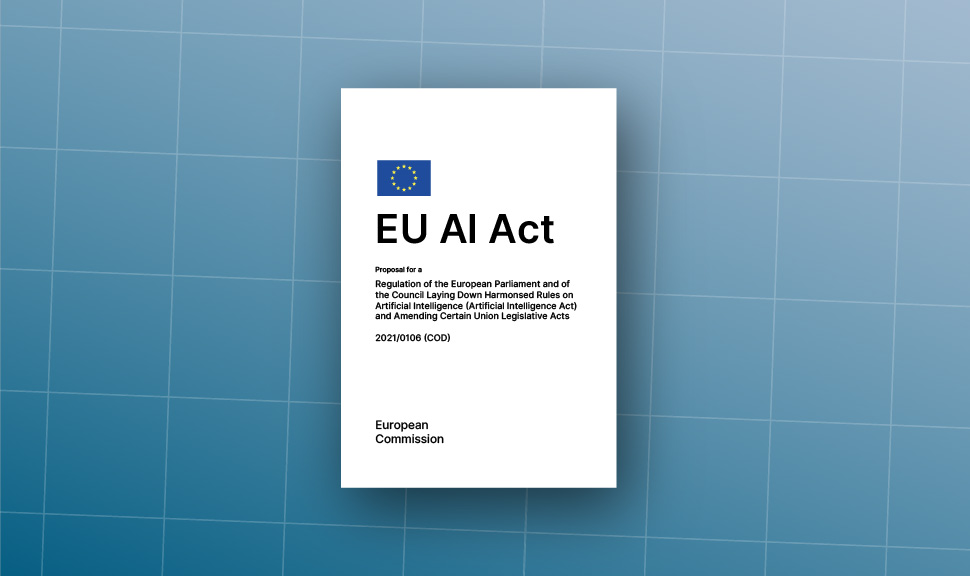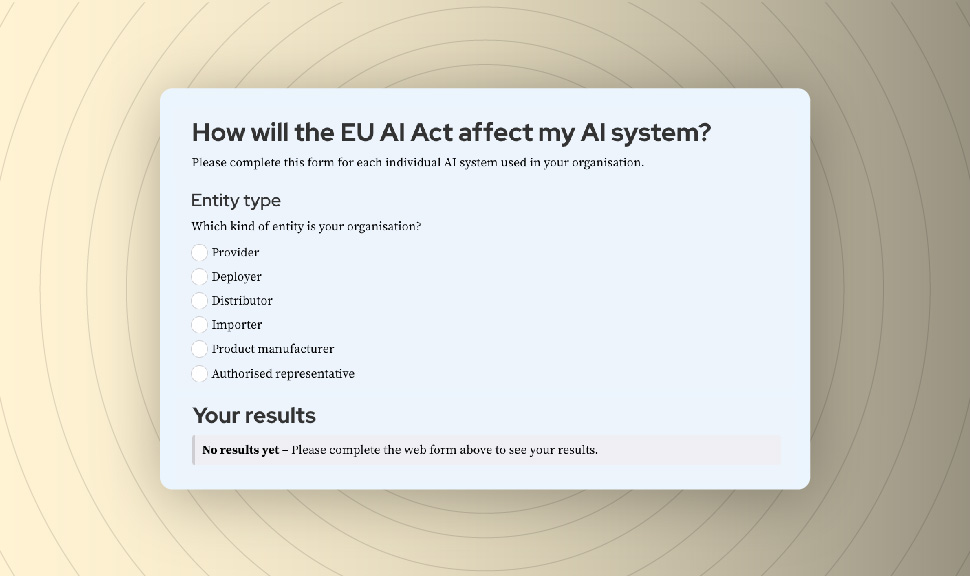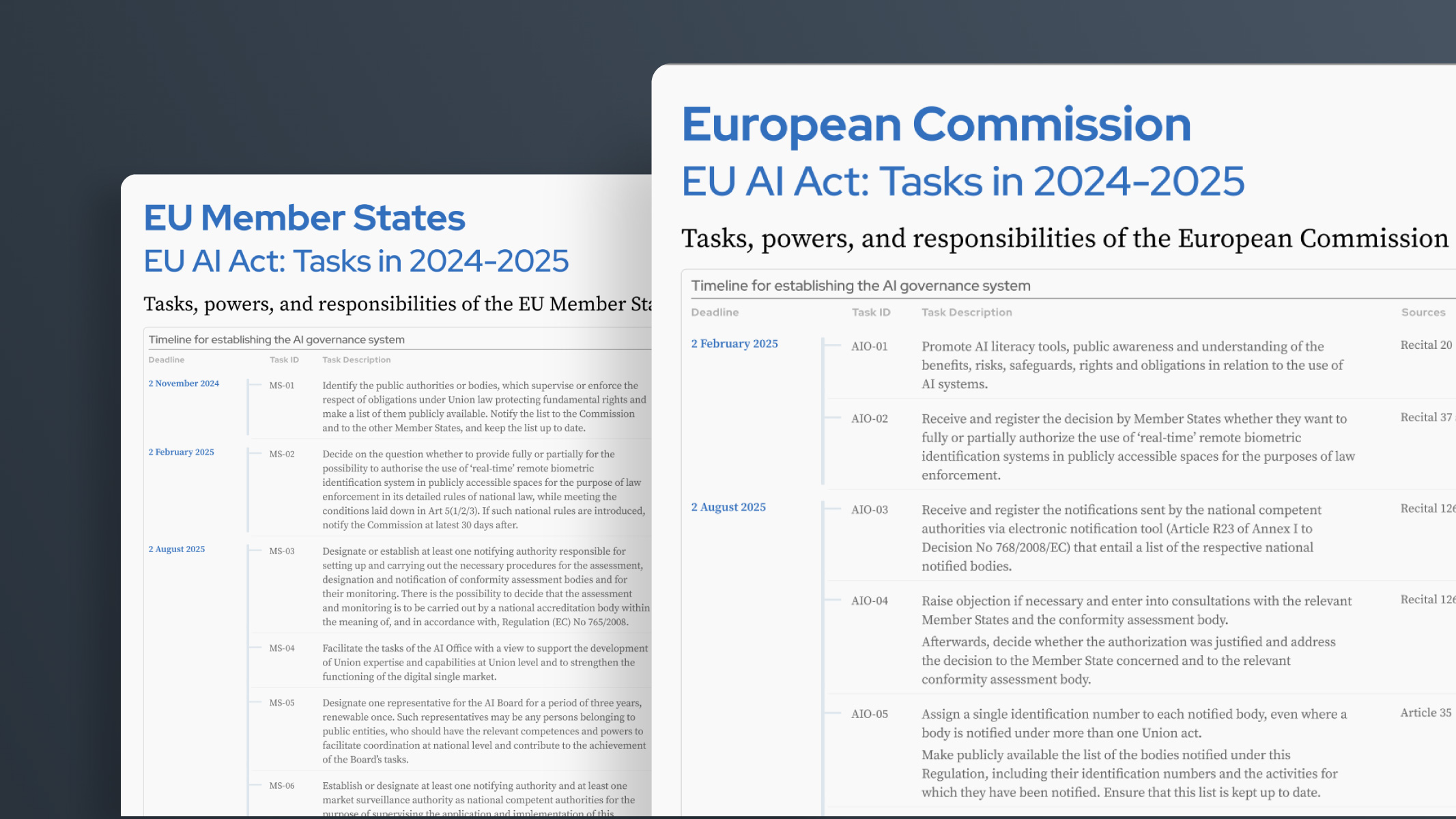🔔 Alert: The AI Office is hiring a Lead Scientific Advisor for AI | Deadline: 13 December 2024 | Compensation: around €13,500-15,000 monthly | More details here
The EU Artificial Intelligence Act
Up-to-date developments and analyses of the EU AI Act
AI Act Explorer
Browse the full AI Act text online. Search within the Act for parts which are relevant to you.

Compliance Checker
Discover how the AI Act will affect you in 10 minutes by answering a series of straightforward questions.

📄 High-Level Summary of the AI Act
Everything you need to know about the AI Act in ten minutes.

Tasks and responsibilities: 2024-25
See an overview and visual timeline of all key tasks for the AI Office (European Commission) and EU Member States as required by the EU AI Act in 2024 and 2025, with references to the sources.
What is the EU AI Act?
The AI Act is a European regulation on artificial intelligence (AI) – the first comprehensive regulation on AI by a major regulator anywhere. The Act assigns applications of AI to three risk categories. First, applications and systems that create an unacceptable risk, such as government-run social scoring of the type used in China, are banned. Second, high-risk applications, such as a CV-scanning tool that ranks job applicants, are subject to specific legal requirements. Lastly, applications not explicitly banned or listed as high-risk are largely left unregulated.

Why should you care?
AI applications influence what information you see online by predicting what content is engaging to you, capture and analyse data from faces to enforce laws or personalise advertisements, and are used to diagnose and treat cancer. In other words, AI affects many parts of your life.
Like the EU’s General Data Protection Regulation (GDPR) in 2018, the EU AI Act could become a global standard, determining to what extent AI has a positive rather than negative effect on your life wherever you may be. The EU’s AI regulation is already making waves internationally – in late September 2021, Brazil’s Congress passed a bill that creates a legal framework for artificial intelligence.

How can organisations apply it?
We have developed an AI Act Compliance Checker to help SMEs and startups better understand whether they might have any legal obligations under the EU AI Act or whether they may implement the Act solely to make their business stand out as more trustworthy. This tool can help give an indication about what obligations your system might face.
Please note that our tool is a simplification. It is still a work in progress.

Articles on the AI Act
The AI Office is hiring a Lead Scientific Advisor for AI
A very important job opening has opened up at the European AI Office: They are hiring for the Lead Scientific Advisor for AI. Application deadline is 13 December 2024. Based on the European Union Employment Advisor, the monthly basic salary for this role (level AD13)...
Overview of all AI Act National Implementation Plans
This post gives an overview of the national authorities to be designated under the AI Act and what we know about the national implementation plans.
The AI Act: Responsibilities of the European Commission (AI Office)
If you are unsure who is implementing and enforcing the new digital law and what the specific time frames are, you might find this post—and our post on the responsibilities of the EU Member States—very helpful. The tables below provide a comprehensive list of all...
The AI Act: Responsibilities of the EU Member States
If you are unsure who is implementing and enforcing the EU AI Act and what the specific time frames are, you might find this post—and our post on the responsibilities of the European Commission (AI Office)—very helpful. The tables below provide you with a...
An introduction to Codes of Practice for the AI Act
Updated: 30 October 2024. This blog post will be updated as new information becomes available. This summary, detailing the Code of Practice for General Purpose AI model providers, was put together by Jimmy Farrell, EU AI policy lead at Pour Demain, and Pour Demain...
Why work at the EU AI Office?
It’s probably not for everyone, but there are a lot of great reasons to consider, including the potential to have an impact on AI governance worldwide, leveraging the first-mover advantage, and more.
Robust governance for the AI Act: Insights and highlights from Novelli et al. (2024)
In their recent publication on robust European AI governance, Claudio Novelli, Philipp Hacker, Jessica Morley, Jarle Trondal, and Luciano Floridi pursue two main objectives: explaining the governance framework of the AI Act and providing recommendations to ensure its...
The AI Office is hiring
The European Commission is recruiting contract agents who are AI technology specialists to govern the most cutting-edge AI models. Deadline to apply is 12:00 CET on 27 March (application form). Role This is an opportunity to work in a team within the...
The AI Office: What is it, and how does it work?
In this overview, we offer a summary of the key elements of the AI Office relevant for those interested in AI governance. We’ve highlighted the responsibilities of the AI Office, its role within the European Commission, its relationship with the AI Board, its national...
AI Act Implementation: Timelines & Next steps
In this article we provide an outline of the key dates relevant to the implementation of the AI Act. We also list some secondary legislation that the Commission might add to supplement the AI Act, and some guidelines it may publish to support compliance efforts....
